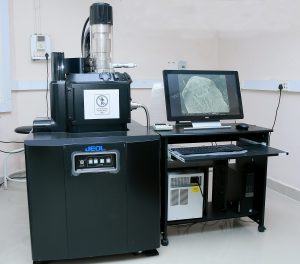Scanning Electron Microscopy
Instrument Details
Model: JSM IT300
Make: JEOL

Working Principle:
The Scanning Electron Microscope (SEM) utilizes electrons to show an enlarged image of a specimen, in the same way as the transmission electron microscope (TEM). Since an electron has a shorter wavelength than light, it enables us to observe smaller things than can be seen with the Optical microscope. The word resolution refers to the smallest size that can clearly be observed (the resolution of the human eye is said to be 0.2 mm). The SEM’s resolution is 0.5 to 4 nm. SEM provides an enlarged image projected onto a fluorescent screen, by using the electrons which were reflected or generated from the surface of the specimen whereas in TEM the image is formed by the electrons transmitted (passed) through the thinly prepared specimen.
Applications:
The JSM IT300 integrated with secondary electron detector that makes it ideal for studying the samples in biology, taxonomy, anatomy and pathology. CIBA has expertise on scanning electron microscopy of biological samples and encourages SEM studies related to biological samples.
Instructions to the Users:
- The samples should be dry and should withstand high vacuum (~ 10 -5 Pa). Users must prepare their samples using appropriate protocols to ensure that the native structure of the organism is retained. Users should care to avoid the introduction of drying artifacts, shrinkage and collapse that can be seen in microphotographs of poorly preserved/ processed specimens.
- Users must take effort to do some research prior to collecting samples and make SEM work easier. Fixation is the first and most important step for optimum preservation of biological samples. Make sure to use the best fixative for collecting and preserving your samples. The sample size for dry samples should be less than diameter: 100 mm Height: 40 mm.
- Wet biological sample withstand low temperature (-10 ◦C - 20 ◦C) can be analysed.
- The user is welcome to be present in the laboratory during analysis.
E-mail ID: director.ciba@icar.gov.in
Scanning electron Microscopy (SEM) charges (Rs.) excluding the GST
| Particulars | Description | Industry | University/National Lab |
| Image analysis | Per Sample | 7500 | 3500 |
Additional Information
- How many days before the user Scientist is to be contacted?
- How the user will be informed?
- How many days are required to analyze the sample?
Inductively Coupled Plasma-Optical Emission Spectrometry
Instrument Details
Model: 5100
Make: Agilent

Working Principle:
Inductively Coupled Plasma-Optical Emission Spectrometry is a powerful tool for the analysis of trace elements and metals in a variety of samples. With this technique, liquid samples are injected into a radio frequency (RF)-induced argon plasma of 10000 K using a nebulizer. Due to the collision between the argon atom and the electrons, desolvation, atomization, and ionization of the sample takes place in the torch. Due to the thermic energy taken up by the electrons, they reach a higher excited state. When the electrons drop back to ground level energy is liberated as light (photons). Each element has its own characteristic emission spectrum.
Applications:
Analysis of trace elements and metals in feed ingredients feeds, fish samples, soil, and water, etc.
User Instructions:
- If materials are given in raw then about 50 g of sample is required and in the case of the dried or grinded sample, the sample amount required is about 5 g. The sample is prepared through microwave digestion. For analysis of liquid water samples, the required amount is 100 ml each.
- Method blanks should always be included in the submitted sample set.
- The submitted sample should be less than 0.1% total dissolved solids (TDS) must be filtered (through a 0.45 μ filter paper) and free of particulates.
E-mail: director.ciba@icar.gov.in
Inductively Coupled Plasma/Optical Emission Spectrometry charges (Rs.) excluding the GST
| Particulars | Description | Industry | University | National Lab/R&D |
| feed ingredients, feeds, fish samples and soil | Per Sample (preparation Charges)+ First element including calibration | 3000 | 2000 | 2000 |
| Per each additional element analysis | 500 | 350 | 350 |
Additional Information
- How many days before the user Scientist is to be contacted?
- How the sample is to be prepared and analyzed?
- How many days are required to analyze the sample?
BD Accuri C6 Plus flow cytometer
Main components: The C6 Plus cytometer is composed of fluidics, optics, and electronics subsystems that work together to analyze cells. The two-laser (Blue laser 488 nm, Red laser 640 nm), six-parameter flow cytometer is composed of fluidics, optics, and electronics systems.

Working principle:
The unique fluidics system of BD Accuri flow cytometers, driven by peristaltic pumps, allows them to determine sample volume, as well as count cells, directly. This feature speeds and simplifies cell analysis by calculating cell concentrations (per unit sample volume).
Application: Estimation of genome size is one of the applications.
User instruction: Estimation of genome size will be carried out only in ready-to-use processed samples provided by the end-user.
Charges (in Rs):
| Particulars | Description | Industry | University National Lab/R&D |
| Flow cytometer | Per sample charges (excluding tax) for estimating genome size | 10000 | 8000 |
Additional Information:
- How many days before the user Scientist is to be contacted?
- How the sample is to be prepared and analyzed?
- How many days are required to analyze the sample?
- How the data is stored?
Contact us
E-mail ID: director.ciba@icar.gov.in